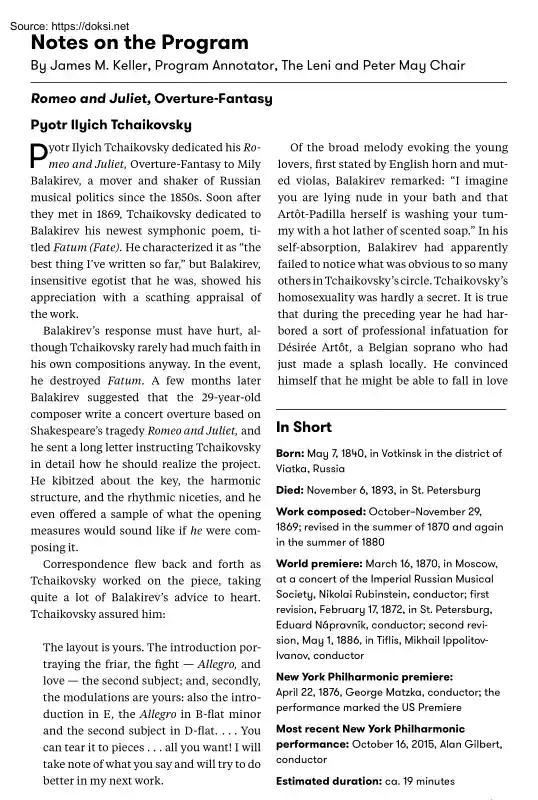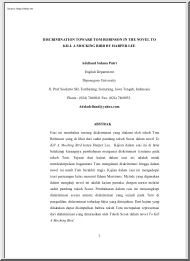Please log in to read this in our online viewer!

Please log in to read this in our online viewer!
No comments yet. You can be the first!
What did others read after this?
Content extract
Notes on the Program By James M. Keller, Program Annotator, The Leni and Peter May Chair Romeo and Juliet, Overture-Fantasy Pyotr Ilyich Tchaikovsky P yotr Ilyich Tchaikovsky dedicated his Romeo and Juliet, Overture-Fantasy to Mily Balakirev, a mover and shaker of Russian musical politics since the 1850s. Soon after they met in 1869, Tchaikovsky dedicated to Balakirev his newest symphonic poem, titled Fatum (Fate). He characterized it as “the best thing I’ve written so far,” but Balakirev, insensitive egotist that he was, showed his appreciation with a scathing appraisal of the work. Balakirev’s response must have hurt, although Tchaikovsky rarely had much faith in his own compositions anyway. In the event, he destroyed Fatum. A few months later Balakirev suggested that the 29-year-old composer write a concert overture based on Shakespeare’s tragedy Romeo and Juliet, and he sent a long letter instructing Tchaikovsky in detail how he should realize the project. He kibitzed
about the key, the harmonic structure, and the rhythmic niceties, and he even offered a sample of what the opening measures would sound like if he were composing it. Correspondence flew back and forth as Tchaikovsky worked on the piece, taking quite a lot of Balakirev’s advice to heart. Tchaikovsky assured him: The layout is yours. The introduction portraying the friar, the fight Allegro, and love the second subject; and, secondly, the modulations are yours: also the introduction in E, the Allegro in B-flat minor and the second subject in D-flat. You can tear it to pieces . all you want! I will take note of what you say and will try to do better in my next work. Of the broad melody evoking the young lovers, first stated by English horn and muted violas, Balakirev remarked: “I imagine you are lying nude in your bath and that Artôt-Padilla herself is washing your tummy with a hot lather of scented soap.” In his self-absorption, Balakirev had apparently failed to notice
what was obvious to so many others in Tchaikovsky’s circle. Tchaikovsky’s homosexuality was hardly a secret. It is true that during the preceding year he had harbored a sort of professional infatuation for Désirée Artôt, a Belgian soprano who had just made a splash locally. He convinced himself that he might be able to fall in love In Short Born: May 7, 1840, in Votkinsk in the district of Viatka, Russia Died: November 6, 1893, in St. Petersburg Work composed: October–November 29, 1869; revised in the summer of 1870 and again in the summer of 1880 World premiere: March 16, 1870, in Moscow, at a concert of the Imperial Russian Musical Society, Nikolai Rubinstein, conductor; first revision, February 17, 1872, in St. Petersburg, Eduard Nápravník, conductor; second revision, May 1, 1886, in Tiflis, Mikhail IppolitovIvanov, conductor New York Philharmonic premiere: April 22, 1876, George Matzka, conductor; the performance marked the US Premiere Most recent New York Philharmonic
performance: October 16, 2015, Alan Gilbert, conductor Estimated duration: ca. 19 minutes NOVEMBER 2019 | 25 with her, and he decided that they should be married. His friends were aghast, and within a few months Artôt’s mother (having been advised by Tchaikovsky’s friend Nikolai Rubinstein, in no uncertain terms, that the composer was not husband material in the traditional sense) swept her daughter off to Warsaw, where Artôt promptly married a Spanish baritone. In the end, this proved a great relief to Tchaikovsky; the real object of his affections just then was Eduard Zak, a 15-year-old student at the Moscow Conservatory. If anyone inspired the erotic languor of the famous melody in this musical study of teenaged lovers, it was surely Eduard rather than Désirée. The work was not a success when Nikolai Rubinstein conducted its premiere, in Moscow in March 1870, and that summer Tchaikovsky undertook extensive revisions. That gave rise to the opening music of the
overture-fantasy as audiences now know it, and then in the summer of 1880 Tchaikovsky again put the piece through a severe rewrite. After fully a decade’s work, Romeo and Juliet (now enriched by a dire, unforgiving coda) reached masterpiece status, an achievement that was recognized in 1884 when it won the 500-ruble Glinka Award, the first of many prizes that would come Tchaikovsky’s way in his remaining years. Instrumentation: two flutes and piccolo, two oboes and English horn, two clarinets, two bassoons, four horns, two trumpets, three trombones, tuba, timpani, cymbals, bass drum, harp, and strings. Views and Reviews Tchaikovsky wrote of the premiere of Romeo and Juliet in Moscow in 1870, “My overture had no success here at all, and was wholly ignored.” He spent the following summer effecting substantial revisions to the piece The beginning of Romeo and Juliet as it is now known dates from this period, with the original E-major pseudo-liturgical chant being replaced by
F-sharp-minor music that maintains an antique sound thanks to the wide-open intervals of the clarinets and bassoons. Balakirev had objected to the original opening, complaining that it reminded him more of a Haydn string quartet than anything suggesting a Catholic friar. Tchaikovsky also deleted a fugue that had seemed out of place in the original version, where it was meant to depict the conflict between the Montagues and the Capulets. The much-feared Viennese critic Eduard Hanslick expressed reservations when he reviewed the piece in 1876, the same year the work was premiered in the US by the New York Philharmonic. Hanslick wrote that the Romeo and Juliet overture “steams cold glistening smoke and rages heated noise.” He continued: Romeo and Juliet, by Frank Dicksee, 1884 26 | NEW YORK PHILHARMONIC As an illustration of a Verona family feud, the Allegro sounds decidedly too Russian. Eight softening bars tell us unambiguously that we approach a love scene. But this motif,
built on the alternation of two dissonant chords, sounds rather like scratching a glass plate with a sharp knife. The love-bliss runs down the spine like a cold snakeskin
about the key, the harmonic structure, and the rhythmic niceties, and he even offered a sample of what the opening measures would sound like if he were composing it. Correspondence flew back and forth as Tchaikovsky worked on the piece, taking quite a lot of Balakirev’s advice to heart. Tchaikovsky assured him: The layout is yours. The introduction portraying the friar, the fight Allegro, and love the second subject; and, secondly, the modulations are yours: also the introduction in E, the Allegro in B-flat minor and the second subject in D-flat. You can tear it to pieces . all you want! I will take note of what you say and will try to do better in my next work. Of the broad melody evoking the young lovers, first stated by English horn and muted violas, Balakirev remarked: “I imagine you are lying nude in your bath and that Artôt-Padilla herself is washing your tummy with a hot lather of scented soap.” In his self-absorption, Balakirev had apparently failed to notice
what was obvious to so many others in Tchaikovsky’s circle. Tchaikovsky’s homosexuality was hardly a secret. It is true that during the preceding year he had harbored a sort of professional infatuation for Désirée Artôt, a Belgian soprano who had just made a splash locally. He convinced himself that he might be able to fall in love In Short Born: May 7, 1840, in Votkinsk in the district of Viatka, Russia Died: November 6, 1893, in St. Petersburg Work composed: October–November 29, 1869; revised in the summer of 1870 and again in the summer of 1880 World premiere: March 16, 1870, in Moscow, at a concert of the Imperial Russian Musical Society, Nikolai Rubinstein, conductor; first revision, February 17, 1872, in St. Petersburg, Eduard Nápravník, conductor; second revision, May 1, 1886, in Tiflis, Mikhail IppolitovIvanov, conductor New York Philharmonic premiere: April 22, 1876, George Matzka, conductor; the performance marked the US Premiere Most recent New York Philharmonic
performance: October 16, 2015, Alan Gilbert, conductor Estimated duration: ca. 19 minutes NOVEMBER 2019 | 25 with her, and he decided that they should be married. His friends were aghast, and within a few months Artôt’s mother (having been advised by Tchaikovsky’s friend Nikolai Rubinstein, in no uncertain terms, that the composer was not husband material in the traditional sense) swept her daughter off to Warsaw, where Artôt promptly married a Spanish baritone. In the end, this proved a great relief to Tchaikovsky; the real object of his affections just then was Eduard Zak, a 15-year-old student at the Moscow Conservatory. If anyone inspired the erotic languor of the famous melody in this musical study of teenaged lovers, it was surely Eduard rather than Désirée. The work was not a success when Nikolai Rubinstein conducted its premiere, in Moscow in March 1870, and that summer Tchaikovsky undertook extensive revisions. That gave rise to the opening music of the
overture-fantasy as audiences now know it, and then in the summer of 1880 Tchaikovsky again put the piece through a severe rewrite. After fully a decade’s work, Romeo and Juliet (now enriched by a dire, unforgiving coda) reached masterpiece status, an achievement that was recognized in 1884 when it won the 500-ruble Glinka Award, the first of many prizes that would come Tchaikovsky’s way in his remaining years. Instrumentation: two flutes and piccolo, two oboes and English horn, two clarinets, two bassoons, four horns, two trumpets, three trombones, tuba, timpani, cymbals, bass drum, harp, and strings. Views and Reviews Tchaikovsky wrote of the premiere of Romeo and Juliet in Moscow in 1870, “My overture had no success here at all, and was wholly ignored.” He spent the following summer effecting substantial revisions to the piece The beginning of Romeo and Juliet as it is now known dates from this period, with the original E-major pseudo-liturgical chant being replaced by
F-sharp-minor music that maintains an antique sound thanks to the wide-open intervals of the clarinets and bassoons. Balakirev had objected to the original opening, complaining that it reminded him more of a Haydn string quartet than anything suggesting a Catholic friar. Tchaikovsky also deleted a fugue that had seemed out of place in the original version, where it was meant to depict the conflict between the Montagues and the Capulets. The much-feared Viennese critic Eduard Hanslick expressed reservations when he reviewed the piece in 1876, the same year the work was premiered in the US by the New York Philharmonic. Hanslick wrote that the Romeo and Juliet overture “steams cold glistening smoke and rages heated noise.” He continued: Romeo and Juliet, by Frank Dicksee, 1884 26 | NEW YORK PHILHARMONIC As an illustration of a Verona family feud, the Allegro sounds decidedly too Russian. Eight softening bars tell us unambiguously that we approach a love scene. But this motif,
built on the alternation of two dissonant chords, sounds rather like scratching a glass plate with a sharp knife. The love-bliss runs down the spine like a cold snakeskin




